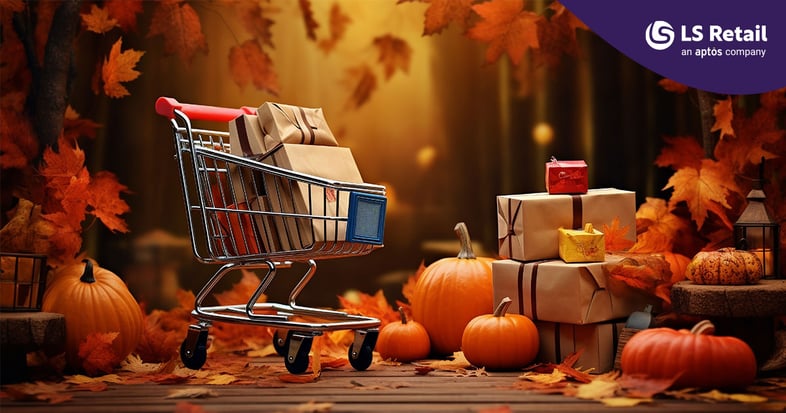
In the not-too-distant past, Halloween served as a colorful demarcation between the summer months and the ensuing winter holidays – a playful omen of the massive consumer-spending to come. According to a new survey from consumer financial services company, Bankrate, 50% of holiday shoppers in the U.S. start making purchases before Halloween.
It’s important to make sure you’re prepared to handle this influx of shoppers and maintain the same quality of customer service you strive for during the rest of the year. With strategic holiday planning, you can face challenges head on and impress your customers. Let’s check out the best ways to avoid being haunted by negative customer experiences over the rest of the holiday season.
1. Eliminate stocking issues
Customers enter your store expecting to find what they’re looking for. This should not be surprising, yet a study done by the IHL Group has shown that retailers are losing more than USD$1 trillion dollars in sales every year due to both out-of-stock and overstock situations. The statistics are shocking, but it indicates an opportunity for your business to be the place that always has what customers want. But to persuade them to purchase, you need the right product availability. Make sure your physical and online stores aren’t overburdened with stock from irrelevant products and are always carrying the “must have” holiday items by optimizing your inventory management system.
How efficient is your replenishment? How automated are your purchase orders? When you maximize the functionality of your inventory system, you can eliminate the waste of over and understocked items by having total visibility of your merchandise. It doesn’t matter how many stores you have or how many channels you sell through, a modern inventory solution will give you a real-time look at the inventory your locations and warehouses are carrying. When your store makes the most out of its inventory management, your customers will leave with both the items they came in for and a great review to share with their family and friends.
2. Offer exceptional promotions
If there’s one thing consumers love, it’s cashing in on great deals. These days, the expectations of consumers are set to assume you will have outstanding sales the moment the jack o’ lanterns have been moved to the clearance table and the leftover Batman costumes have been marked down. Shoppers start hunting for deals in droves when the calendar flips to November 1st, and it’s up to you to be ready for them. This means the benefits of preparing for and running promotions for your retail business can’t be underestimated.
Ideally, your promotions should benefit both your business goals and your customers’ demands. Know where your pricing fits in the market relative to your competitors’ prices and measure the success rates of previous promotions. Be careful to maintain the perceived “value” of your products when promoting sale prices – your customers would rather buy a product of value than one with a price that is suspiciously low. Running several different promotions at once can allow you to target a wider variety of shoppers. This can be complicated, but if you select a retail management system with powerful promotional functionality, the process of running compelling deals is easily done. You can manage multiple promotions at once, plan their periods of activity, set a hierarchy that clarifies which promotion should override other promotions, and track the results of each campaign.
Customers will have positive experiences when you offer bundle discounts, initiate buy-one-get-one-free deals and create personalized offers that can fit their tastes while maintaining a considerable profit for your business. These strategies are not only great for improving your margins, but also give your shoppers the sense of satisfaction that comes from getting all the items on their lists at great prices.
3. Reward loyalty
 As you seek to provide an amazing customer experience for your shoppers, it’s important to remind them of how important they are to your business. With the implementation of a loyalty program, your stores can share their investment in the customer’s satisfaction with the customer themselves. You can strengthen their connection to your brand by delighting them with surprise discounts, custom-tailored to their purchase history.
As you seek to provide an amazing customer experience for your shoppers, it’s important to remind them of how important they are to your business. With the implementation of a loyalty program, your stores can share their investment in the customer’s satisfaction with the customer themselves. You can strengthen their connection to your brand by delighting them with surprise discounts, custom-tailored to their purchase history.
Plus, the more your shoppers take advantage of these promotions, the more you’ll be able to gain further insight into their spending habits. This means your future rewards will be even more targeted to their preferences, and you could even include limited-edition items or personalized experiences. When you know your customers well, it’s easy to design rewards that really hit the mark. A clear insight into what your most loyal customers love can also help you improve your long-term inventory management.
Globally, 56% of consumers say they’re more likely to buy from a brand with a loyalty program, so what are you waiting for? These kinds of programs can easily be set up and made available across all your touchpoints, so customers can gain access online and via their mobile devices, which offers them much more convenience and flexibility. Let your faithful shoppers know that your business values their business and delight them with an unexpected but personalized purchasing experience.
4. Embrace a unified retail platform
With most consumers incorporating online technology into their daily routines, the reality is that your business should have both traditional and online storefronts. It is equally important that these storefronts can share data in real-time, so all your sales channels can make the most of what your business has to offer.
Some retailers attempt to solve this issue by using add-ons which they integrate with their current systems. However, these can leave you with a Frankenstein’s monster of different modules and vendors, all producing inconsistent data and functioning with suboptimal efficiency. As a result, you are left with frustrated customers who, after spending time comparing their options and deciding which to buy, end up with an email two days later telling them their item can’t be delivered – “Sorry, we just realized it’s out-of-stock!” Or worse, they may order an in-stock item online with pick-up in-store, only to be told at the location that it’s actually unavailable. 58% of consumers say it’s important that inventory status is visible online when shopping, reports Gartner.
With a unified retail management system like LS Central, you can decide which e-commerce promotions should match those found in your street-side locations, while also allowing shoppers to return and exchange items purchased online at in-store customer service counters. Most importantly, you’ll be able to match the inventory numbers shown on your site to your locations. Providing your shoppers with convenient and accurate product information is a sure-fire way to deliver a phenomenal experience.
5. Prioritize the employee experience
Even though technology might be the foundation for how your business operates, you shouldn’t underestimate the power of human interaction. Whether it’s by phone, email, or on the salesfloor, the quality of your customer service shapes how your customers perceive your brand.
Customers enter your store or website with a certain set of expectations, so your staff should be able to consistently represent your business’ culture of customer service no matter where they are. Make sure you have a clearly defined set of beliefs regarding the customer experience, and don’t shy away from investing in training programs that can offer further guidance and interaction with these values. And with so many businesses hiring seasonal employees, it’s especially important that they have all the tools they need to provide excellent customer service on the sales floor, such as an intuitive Point of Sale system that allows them to get trained quickly and efficiently.
Your employees will also find it easier to meet and exceed customer expectations the more your culture empowers them to be friendly, informed, and responsive. If the customer is having a negative experience, your employee should feel comfortable “making it right,” even if that means giving them special pricing or in-store credit. Acknowledging a negative experience and quickly responding to it can make all the difference when trying to maintain customer loyalty.
6. Respond to customer feedback
Even if you’ve done your diligence regarding inventory, promotions, loyalty rewards, employees, and your retail system, you might still find yourself faced with negative customer experiences. It happens despite your best intentions and under even the best of circumstances. What matters is that you respond to your customers’ feedback in a proactive way that shows you are invested in their opinion of your services. Remember, if they’re taking the time to inform you of a poor customer experience, there’s a very good chance they will also take their complaints to your other customers. And perhaps worst of all, 73% of customers will switch to one of your competitors after multiple bad experiences.
The same qualities your customers seek through human interaction when shopping can be applied when responding to negative feedback: empathy, friendliness, and a genuine willingness to make things right. Prepare to accept your business’ potential shortcomings and use your customers’ critique as a guidepost for finding solutions. The success of your business is built on the relationship you maintain with your customers. Be their champion when they are dissatisfied with their experience, and they will most likely continue to champion you.
With the holiday period frighteningly close, there is no time to lose in making sure you have all your holiday sales strategies in place. For more information, talk to our experts.

